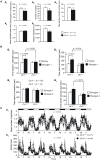Comprehensive Behavioral Analysis of Male Ox1r (-/-) Mice Showed Implication of Orexin Receptor-1 in Mood, Anxiety, and Social Behavior
- PMID: 26696848
- PMCID: PMC4674555
- DOI: 10.3389/fnbeh.2015.00324
Comprehensive Behavioral Analysis of Male Ox1r (-/-) Mice Showed Implication of Orexin Receptor-1 in Mood, Anxiety, and Social Behavior
Abstract
Neuropeptides orexin A and orexin B, which are exclusively produced by neurons in the lateral hypothalamic area, play an important role in the regulation of a wide range of behaviors and homeostatic processes, including regulation of sleep/wakefulness states and energy homeostasis. The orexin system has close anatomical and functional relationships with systems that regulate the autonomic nervous system, emotion, mood, the reward system, and sleep/wakefulness states. Recent pharmacological studies using selective antagonists have suggested that orexin receptor-1 (OX1R) is involved in physiological processes that regulate emotion, the reward system, and autonomic nervous system. Here, we examined Ox1r (-/-) mice with a comprehensive behavioral test battery to screen additional OX1R functions. Ox1r (-/-) mice showed increased anxiety-like behavior, altered depression-like behavior, slightly decreased spontaneous locomotor activity, reduced social interaction, increased startle response, and decreased prepulse inhibition. These results suggest that OX1R plays roles in social behavior and sensory motor gating in addition to roles in mood and anxiety.
Keywords: anxiety; emotion; hypocretin; orexin; orexin receptor 1 (OX1R); social behavior.
Figures





References
LinkOut - more resources
Full Text Sources
Other Literature Sources
Molecular Biology Databases

